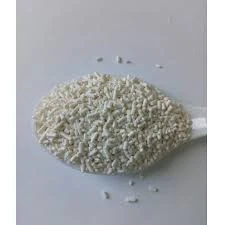
Understanding the Role of Sodium Acid Pyrophosphate in Food Products and Its Uses
Understanding Sodium Acid Pyrophosphate in Food Uses, Benefits, and Safety
Sodium acid pyrophosphate (SAPP) is a food additive that plays a vital role in the modern food industry. Often classified as a leavening agent, it is primarily utilized in baked goods, sauces, and processed foods. This article delves into the uses, benefits, and safety of sodium acid pyrophosphate, shedding light on its significance in the culinary world.
What is Sodium Acid Pyrophosphate?
Sodium acid pyrophosphate is a white, crystalline powder with the chemical formula Na2H2P2O7. It is a type of pyrophosphate, formed by the condensation of phosphoric acid. As a food additive, it is often identified by its E number, E450i, when listed on ingredient labels. SAPP is known for its ability to act as a buffering agent, emulsifier, and stabilizer, making it a versatile addition to many food products.
Common Uses in Food Products
One of the primary applications of sodium acid pyrophosphate is in the baking industry. It is frequently used in batters, doughs, and quick breads as a leavening agent. When combined with baking soda, SAPP releases carbon dioxide gas, resulting in a lighter and airier texture in baked goods. This property is especially important for products like cakes, muffins, and pancakes, where a fluffy consistency is desired.
In addition to baking, sodium acid pyrophosphate functions as a preservative in various food items. It helps maintain the color and texture of processed foods, preventing premature spoilage. For example, it can be found in items such as potato products, where it aids in maintaining a fresh appearance and preventing browning.
SAPP is also commonly used in foods such as frozen and processed seafood products. Its ability to bind water helps retain moisture, enhancing the eating quality of these items. Moreover, sodium acid pyrophosphate is utilized in the production of canned and dehydrated foods to improve texture and flavor.
sodium acid pyrophosphate food

Nutritional and Sensory Benefits
Beyond its functional applications, sodium acid pyrophosphate also contributes to the sensory attributes of food. It helps in controlling the pH levels, which can influence flavor and taste. By adjusting the acidity of food products, SAPP enhances the overall palatability, making dishes more appealing to consumers.
Moreover, the use of sodium acid pyrophosphate can enhance the nutritional profile of certain foods. In specific formulations, it acts as a mineral source, particularly phosphorus, which is essential for bone health and various metabolic processes in the body.
Safety and Regulatory Status
Sodium acid pyrophosphate is considered safe for consumption when used within the established regulatory limits. Various health organizations, including the Food and Drug Administration (FDA) and the European Food Safety Authority (EFSA), have evaluated its safety and approved its use in food products. Studies indicate that SAPP does not pose significant health risks when consumed in typical amounts found in food.
However, like any food additive, excessive consumption can lead to potential health issues. This is especially pertinent for individuals who may be sensitive to phosphates or have specific dietary restrictions. It is always advisable to read food labels and consume products containing additives in moderation.
Conclusion
Sodium acid pyrophosphate is a significant food additive that enhances the quality, texture, and safety of many food products. Its versatility as a leavening agent and preservative makes it invaluable in the food industry. With regulatory bodies deeming it safe for consumption, sodium acid pyrophosphate plays an essential role in ensuring the consistency and palatability of the foods we enjoy daily. As consumers become increasingly aware of the ingredients in their food, understanding additives like SAPP can empower them to make informed dietary choices.
-
Understanding Synthetic Rubber OptionsNewsApr.27,2025
-
Trichloroisocyanuric Acid: Essential for Clean and Safe WaterNewsApr.27,2025
-
Sodium Dichloroisocyanurate: Key to Safe Water TreatmentNewsApr.27,2025
-
Sodium Acid Pyrophosphate: Essential in Modern Food ProcessingNewsApr.27,2025
-
Essential Water Treatment ChemicalsNewsApr.27,2025
-
Denatured Alcohol and Its Industrial UsesNewsApr.27,2025
-
The Versatile Uses of Sodium BicarbonateNewsApr.24,2025
Hebei Tenger Chemical Technology Co., Ltd. focuses on the chemical industry and is committed to the export service of chemical raw materials.
-

view more DiethanolisopropanolamineIn the ever-growing field of chemical solutions, diethanolisopropanolamine (DEIPA) stands out as a versatile and important compound. Due to its unique chemical structure and properties, DEIPA is of interest to various industries including construction, personal care, and agriculture. -

view more TriisopropanolamineTriisopropanolamine (TIPA) alkanol amine substance, is a kind of alcohol amine compound with amino and alcohol hydroxyl, and because of its molecules contains both amino and hydroxyl. -

view more Tetramethyl Thiuram DisulfideTetramethyl thiuram disulfide, also known as TMTD, is a white to light-yellow powder with a distinct sulfur-like odor. It is soluble in organic solvents such as benzene, acetone, and ethyl acetate, making it highly versatile for use in different formulations. TMTD is known for its excellent vulcanization acceleration properties, which makes it a key ingredient in the production of rubber products. Additionally, it acts as an effective fungicide and bactericide, making it valuable in agricultural applications. Its high purity and stability ensure consistent performance, making it a preferred choice for manufacturers across various industries.











